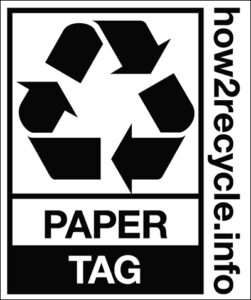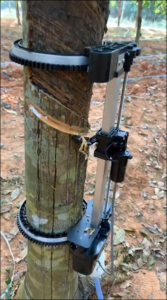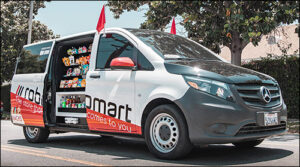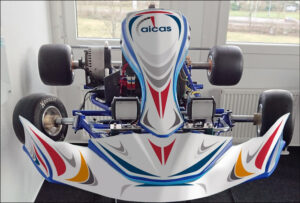Sep 30, 2021Presented here are recent news announcements regarding the following organizations: Avery Dennison Smartrac, How2Recycle, STMicroelectronics, CIHEVEA, Robomart, Senet, Helium, the Industry IoT Consortium, SpotOn, Appetize and LiFi Beam.
Avery Dennison Smartrac Receives How2Recycle Label for RFID Paper Hangtags
Avery Dennison Smartrac has announced that it has become the first prequalified intelligent labels provider to receive How2Recycle's label for RFID paper hangtags. The label was assigned based on several factors, the company reports, including applicable law, collection (access to recycling), sortation (MRF package flow), reprocessing (technical recyclability) and end markets. This development, according to Avery Dennison, follows research and development to develop a combination of materials, adhesives and inlay construction that will enable RFID labels to be recycled alongside residential recycling streams, and to be transformed with other paper-based materials.
 Packaging design is diverse and complex, the company explains, and recyclability can change based on product application, packaging design and other factors. The How2Recycle label, created to provide consistent and transparent on-package recycling information to consumers in North America, involves a coalition of brands that want packaging to be recycled and that provide consumers with smart packaging labels. How2Recycle is a part of independent environmental non-profit organization GreenBlue.
Packaging design is diverse and complex, the company explains, and recyclability can change based on product application, packaging design and other factors. The How2Recycle label, created to provide consistent and transparent on-package recycling information to consumers in North America, involves a coalition of brands that want packaging to be recycled and that provide consumers with smart packaging labels. How2Recycle is a part of independent environmental non-profit organization GreenBlue.
"This recognition follows many years of R&D to develop the right materials and design to ensure that our labels are as easy to recycle as many of the products they appear on," said Tyler Chaffo, Avery Dennison Smartrac's manager for global sustainability comments, in a prepared statement. "We are proud to be the first intelligent labels provider to meet the exacting requirements of How2Recycle and look forward to receiving confirmation from similar bodies globally."
Hal Hikita, the company's head of product line management, added in the prepared statement, "This development follows the launch of Avery Dennison's Sustainable ADvantage in July, a portfolio of products and solutions that enables companies across global industries to use fewer natural resources, cut carbon emissions, reduce waste and build toward a low-carbon, circular economy. By solving the challenge of ensuring that paper-based RFID labels can be recycled alongside the materials they are attached to, this ensures our customers can help reach their goals for a sustainable future."
STMicroelectronics, CIHEVEA Deploy LoRa SoC for Smart Farming
STMicroelectronics, a semiconductor provider for electronics applications, has announced a customer application for its STM32WLE5 LoRa system-on-chip (SoC). Automated rubber-tapping specialist CIHEVEA uses the SoC's low-power networking functionality to automate the extracting of latex from rubber trees. CIHEVEA has equipped more than 200,000 rubber trees on its Hainan plantation with the solution in order to improve rubber-tapping productivity and output capacity.
 The SoC is designed to act as a low-power communication hub and control center for CIHEVEA's Rubber Tapping Robot, STMicroelectronics explains. The robot includes two precision motors and a series of environmental sensors that monitor weather conditions, including temperature, air pressure and humidity. Clamped to a tree, the STM32WLE5 transmits sensor data to a mesh gateway via a dedicated LoRa application network server, which can monitor, test, debug and coordinate the robots in the field. Once all preset conditions are met, the SoC triggers the rubber-tapping motors to perform autonomous cutting, which usually occurs early in the morning.
The SoC is designed to act as a low-power communication hub and control center for CIHEVEA's Rubber Tapping Robot, STMicroelectronics explains. The robot includes two precision motors and a series of environmental sensors that monitor weather conditions, including temperature, air pressure and humidity. Clamped to a tree, the STM32WLE5 transmits sensor data to a mesh gateway via a dedicated LoRa application network server, which can monitor, test, debug and coordinate the robots in the field. Once all preset conditions are met, the SoC triggers the rubber-tapping motors to perform autonomous cutting, which usually occurs early in the morning.
Leveraging the STM32WLE5 and LoRa networking, ST reports, CIHEVEA's solution has increased latex yield while minimizing damage to trees and prolonging their lifespans. The rubber-tapping robot is designed to resolve chronic labor challenges, as tree tapping can be difficult and dangerous for workers. The multi-modulation wireless SoC microcontroller features an Arm Cortex‐M4 core running at 48 MHz, a sub-GHz radio allowing long-range connectivity and a variety of peripherals. Sized at 5 millimeters by 5 millimeters (0.2 inch by 0.2 inch), the device is built to meet the agriculture industry's robustness and performance requirements. The microcontroller is open-platform, supporting LoRa, (G)FSK, (G)MSK and BPSK modulations.
"The fully automatic, intelligent, rubber-tapping system is a revolution for the rubber industry," said Xu Zhen Kun, CIHEVEA's vice-chairman, in a prepared statement. "With the increased use of platform technology and the ability to communicate via the low-power LoRa network technology provided by the STM32WLE5, the smart rubber plantation platform system is creating a new rubber plantation ecosystem, moving away from traditional high-intensity, heavy-pollution, inefficient, production methods, and is ushering in a new era of green environmental protection, high efficiency and digital transformation."
"While rubber trees are a sustainable source of an important material widely used in the industrial, transport and agriculture sectors, improving rubber-tapping efficiency and increasing latex yield has long been a goal of rubber producers, and using the STM32WL5 and its LoRa networking is a natural fit," added Arnaud Julienne, the VP of STMicroelectronics' Microcontrollers and Digital ICs Group, in the prepared statement. "Moreover, our unique and broad portfolio of products and solutions in connectivity, sensing and large portfolio of power-management and motor-control solutions is well suited to the full range of smart farming domains, including tracking, irrigation systems, tractors, and livestock position and health monitoring."
Robomart Unveils Fast-Delivery Retail Platform
Robomart, a store-hailing service that operates a fleet of on-demand mobile mini-marts (see The Convenience Store That Visits You and Driverless Mobile Store Leverages RFID to Bring Food to Customers), has announced the launch of its Retailer Platform, enabling retail companies to partner with Robomart to deploy branded stores on wheels that consumers can summon to their door. The company's delivery-shopping system is designed to help retailers increase deliveries by up to 500 percent, Robomart reports.
The delivery experience, from when a consumer opens the Robomart app to when they have goods in hand, has been recorded at less than two minutes, according to the company, with nine minutes being the average engagement time. Reservations for the platform are now being accepted on a first-come, first-served basis, with deployments set to commence early next year. Consumers can hail a Robomart using the proprietary app, then open the vehicle's doors and choose products once it arrives. The company's RFID-based, checkout-free system allows customers to take their selected products and walk away without physically checking out and paying.
 With Robomart's platform, retailers can book any of six available vehicle types: snack, grocery, pharmacy, café, ice cream and fast food. The snack, grocery and café Robomarts are equipped with refrigeration modules to keep perishable items fresh and drinks cold, and these vehicles, along with the pharmacy model, are expected to be available for deployment in early 2022. The ice cream and fast food Robomarts are currently in development and are expected to join the fleet later next year.
With Robomart's platform, retailers can book any of six available vehicle types: snack, grocery, pharmacy, café, ice cream and fast food. The snack, grocery and café Robomarts are equipped with refrigeration modules to keep perishable items fresh and drinks cold, and these vehicles, along with the pharmacy model, are expected to be available for deployment in early 2022. The ice cream and fast food Robomarts are currently in development and are expected to join the fleet later next year.
Retailers can decide which of their products to feature as stock-keeping units within the scope of each Robomart type, as well as set the pricing of their products. They can receive personalized, full-vehicle branding and select from available operating zones in the Greater Los Angeles area in which to deploy. With restocking stations in each zone, Robomart will manage all product stocking, tagging, scanning, quality control and replenishment, and retailers will have access to a reporting dashboard to observe sales data and analytics.
"Since our consumer launch earlier this summer, we have been overwhelmed with the positive feedback and demand for Robomarts, which shows consumers are looking for a more convenient and faster way to get goods to their door," said Ali Ahmed, the company's cofounder, in a prepared statement. "This new Retailer Platform will help us expand our offerings and provide a unique way for retailers to increase their reach and delivery capabilities, faster than ever before. We founded Robomart with the vision to create the fastest way to shop, and this launch allows us to power next-minute delivery for retailers."
Senet, Helium Partner on LoRaWAN Network Integration
Senet, a provider of cloud-based software and services platforms offering global connectivity and on-demand network build-outs for the Internet of Things (IoT), and Helium, which offers peer-to-peer wireless networks, have announced a network-roaming integration intended to broaden access to public LoRaWAN network connectivity for customers deploying IoT applications throughout the United States. Helium's network joins a growing number of network operators, radio access network partners and network infrastructure providers that have partnered with Senet to make LoRaWAN connectivity accessible when and where needed, the companies report.
Senet operates a national public, carrier-grade LoRaWAN network. Through this roaming integration, the company explains, its customers deploying enterprise and consumer-grade devices will now have expanded access to public network coverage provided by more than 175,000 Helium-compatible hotspots deployed by individuals throughout the country. This network access, available from Senet under its Extended Coverage offering, is supported by Senet's network-management services.
For Helium-compatible hotspot owners, the partnership provides an opportunity for increased network traffic generated by high-density IoT applications being deployed by Senet customers, such as asset tracking, logistics, supply chain monitoring, environmental monitoring, and smart-city services. These customers represent more than a billion transactions processed on the Senet network annually. Accumulated data transfer and proof-of-coverage transactions earn hotspot owners HNT cryptocurrency for their help in building and maintaining the network infrastructure.
"Our collaboration with the Helium network demonstrates Senet's commitment to leading through a combination of innovation and partnerships," said Bruce Chatterley, Senet's CEO, in a prepared statement. "Helium created a unique and complementary business model for deploying LoRaWAN networks, and the combination of extended network coverage and the potential economic incentive of HNT puts Senet and the Helium network in a leading position to move the market a step closer to pervasive low-power wide-area network coverage for IoT applications throughout the United States."
"Senet's dominant position in the commercial LoRaWAN network market and experience with scaled IoT solution deployments are examples of the success we look for as we partner to deliver value to the Helium ecosystem," added Amir Haleem, Helium's CEO and cofounder, in the prepared statement. "This is an exciting announcement for the industry. The roaming integration with Senet is made possible by the Helium blockchain and brings together two of the fastest-growing LoRaWAN networks in the United States, delivering a significant opportunity for our hotspot owners to benefit from the rapidly growing IoT services economy."
Industry IoT Consortium Launches Automotive OTA Updates Testbed
The Industry IoT Consortium (IIC) has announced its IIC Automotive Over-the-Air (OTA) Updates Testbed, designed to show manufacturers how to deploy, update and replace software on a fleet of vehicles or devices remotely. The testbed can make updates from almost anywhere, the organization reports, limiting updates to what is required and authorized, and it ensures the safety and security of passengers by focusing on system trustworthiness, security, safety, integrity, privacy and resilience.
 "The Automotive OTA Updates Testbed provides real-world validation for the crucial elements of an automobile, including software and security updates, car communications, after-market updates and new services," said Howard Kradjel, the IIC's VP of industry programs, in a prepared statement. "Manufacturers can also apply learnings from the Automotive OTA Updates Testbed to medical equipment, industrial machinery and other devices."
"The Automotive OTA Updates Testbed provides real-world validation for the crucial elements of an automobile, including software and security updates, car communications, after-market updates and new services," said Howard Kradjel, the IIC's VP of industry programs, in a prepared statement. "Manufacturers can also apply learnings from the Automotive OTA Updates Testbed to medical equipment, industrial machinery and other devices."
With the "Go,Kart!"—a replica of a fully functional connected vehicle—as its base platform, the testbed integrates access technologies, security, applications and services to deliver software updates. The IIC based the Automotive OTA Updates Testbed on the Open Service Gateway Initiative, a Java-based framework for developing and deploying modular software programs and libraries, as the onboard gateway between a vehicle and the cloud. The testbed employs various commercially available connectivity technologies, such as 5G, Wi-Fi and Li-Fi.
"The testbed introduced Li-Fi as a complementary wireless communication option for OTA updates and general V2X communication to address RF challenges, such as signal interference, jamming and limited capacity," added Dirar Hakeem, ASSA's cofounder and one of the testbed leads, in the prepared statement. "The combination of wireless technologies ensures stable OTA updates, vehicle-to-everything communication and efficient operations."
The testbed enables manufacturers to manage the entire DevOps cycle of an automobile, the consortium explains, from development to testing, deployment and operations, mitigating cybersecurity risks inherent in the integration of IT and OT. "The IIC Automotive OTA Updates Testbed seamlessly bridges the IT-to-OT gap," added James J. Hunt, AICAS's CTO another testbed lead, in the prepared statement. "It shows manufacturers how to produce effective and trustworthy electrified, autonomous automobiles for the future."
SpotOn Raises Funding to Acquire Appetize
SpotOn, which offers software and payments solutions for restaurants and retail businesses, has announced $300 million in Series E funding, to be used to acquire Appetize, a digital and mobile commerce platform for enterprise businesses, such as sports and entertainment venues, theme parks, zoos, college campuses and more. The round was led by Andreessen Horowitz, with participation from DST Global, 01 Advisors, Dragoneer Investment Group, Franklin Templeton, Mubadala Investment, Wellington Management and Coatue Management. This comes four months after SpotOn's Series D funding, the company reports, and increases its valuation from $1.875 to $3.15 billion.
"This investment enables SpotOn to significantly increase its total addressable market with an end-to-end platform for restaurants and retail business of all types and sizes," said David George, Andreessen Horowitz's general partner, in a prepared statement. "The acquisition is a natural fit given the companies' complementary technology and shared focus on market-leading customer support." With the acquisition, SpotOn intends to provide Appetize's offerings to thousands of regional entertainment centers, stadiums, colleges and universities.
"From our first meetings with Appetize, we knew they had great people and a great product, and the more we worked together it became clear that our two companies were stronger together," added Matt Hyman, SpotOn's co-CEO, in the prepared statement. "We are combining our complementary technologies, extending our market coverage and retaining our shared passion for great service and support for our clients. SpotOn is quickly becoming a part of everyday life for consumers across the country whenever they shop, dine or visit a stadium or a college campus."
Max Roper, Appetize's CEO, who will run the business as part of SpotOn, added: "Appetize has built a truly special team and product that is trusted by some of the most iconic brands in hospitality, from Yankee Stadium to LSU to the San Diego Zoo. Likewise, SpotOn has earned the trust of tens of thousands of small businesses and independent restaurants with their technology and team."
The acquisition, Roper said, enables the combined team to accelerate investments into their product and client base, while filling a void in the mid-market space. "By bringing the two companies together," he added in the statement, "businesses from a major league ballpark to a local clothing boutique will have access to modern, intuitive, cloud-based technology that delivers exceptional customer experiences from one trusted provider."
LiFi Beam Funds Light Fidelity Network Installations
LiFi Beam has announced the completion of a Series A funding round led by Star Capital. The round closed at $17 million and will take the form of a fixed volume of BEAM token. "The funding will allow us to build out the manufacturing capabilities we currently have," said LiFi Beam representative Kenneth Yau in a prepared statement, "which will accelerate the completion of our project pipeline and free up assets for delivering new business, in particular our street lighting rollouts for network offload."
Light fidelity (Li-Fi) technology uses the visible light spectrum to transfer data, as opposed to radio frequencies, which is the case for Wi-Fi systems. This allows for speeds of up to 42 gigabytes per second on a bandwidth that is nearly 400 THz, the company explains, which is around a thousand times greater than what is possible with Wi-Fi technologies.
The street lighting program is a joint collaboration between LiFi Beam and regional councils and cities around the world to install the company's technology in state-owned lighting, such as streetlights. The lighting infrastructure, which is typically publicly owned, can monetize the deployment by selling spectrum assets to mobile network providers with capacity issues, LiFi Beam explains. The data received via uplink can benefit infrastructure owners, the company reports, while supporting emergency service efforts via geolocation.
LiFi Beam works with commercial clients in the public and private sectors to develop vehicle-to-vehicle communications and vehicle-to-infrastructure communications, including connected motorways, retail sites with advanced customer experience applications, and medical installations such as robotic surgery centers. In addition, the firm provides chipsets and firmware that can be integrated into device hardware, and it has developed a router that offers both Li-Fi and Wi-Fi technologies in a single unit, allowing users to swap between the two protocols as needed.

